The smart built-in kitchen appliance industry stands at the threshold of a decade-long expansion trajectory that promises to reshape home automation and commercial kitchen technology. The market's journey from USD 8,890.3 million in 2025 to USD 37,887.2 million by 2035 represents substantial growth, demonstrating the accelerating adoption of intelligent kitchen systems and connected appliance technology across residential and commercial sectors.
The first half of the decade (2025-2030) will witness the market climbing from USD 8,890.3 million to approximately USD 18,352.9 million, adding USD 9,462.6 million in value, which constitutes 32% of the total forecast growth period. This phase will be characterized by the rapid adoption of smart refrigeration systems, connected dishwashers, and intelligent cooking appliances driven by increasing home automation trends and commercial kitchen modernization requirements worldwide. Advanced connectivity capabilities and AI-powered control features will become standard expectations rather than premium options.
The latter half (2030-2035) will witness accelerated growth from USD 18,352.9 million to USD 37,887.2 million, representing an addition of USD 19,534.3 million or 68% of the decade's expansion. This period will be defined by mass market penetration of integrated smart kitchen ecosystems, seamless IoT connectivity, and comprehensive compatibility with existing home automation infrastructure. The market trajectory signals fundamental shifts in how consumers and commercial establishments approach kitchen management and food preparation, with participants positioned to benefit from sustained demand across multiple product and application segments.
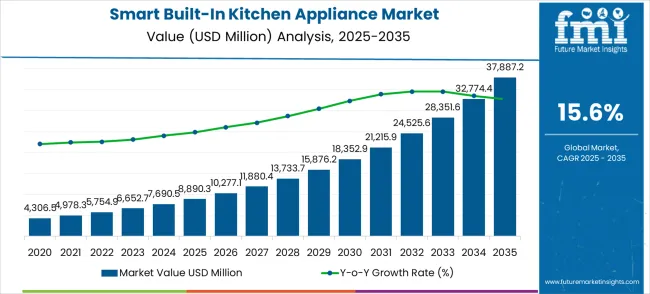
The smart built-in kitchen appliance market demonstrates distinct growth phases with varying market characteristics and competitive dynamics. Between 2025 and 2030, the market progresses through its technology adoption phase, expanding from USD 8,890.3 million to USD 18,352.9 million with aggressive annual increments averaging 15.6% growth. This period showcases the transition from basic smart appliances to advanced systems with enhanced connectivity capabilities and integrated AI-powered control systems becoming mainstream features.
The 2025-2030 phase adds USD 9,462.6 million to market value, representing 32% of total decade expansion. Market maturation factors include standardization of IoT protocols, declining component costs for smart sensors and connectivity modules, and increasing consumer awareness of smart kitchen benefits, reaching 90-95% energy efficiency in connected appliance applications. Competitive landscape evolution during this period features established appliance manufacturers like BSH Hausgeräte GmbH and Whirlpool Corporation expanding their smart kitchen portfolios while technology companies focus on connectivity solutions and AI integration capabilities.
From 2030 to 2035, market dynamics shift toward comprehensive smart home integration and commercial kitchen automation, with growth accelerating from USD 18,352.9 million to USD 37,887.2 million, adding USD 19,534.3 million or 68% of total expansion. This phase transition centers on fully integrated smart kitchen ecosystems, seamless connectivity with home management systems, and deployment across diverse residential and commercial scenarios, becoming standard rather than specialized applications. The competitive environment matures with focus shifting from basic smart features to comprehensive kitchen automation systems and integration with broader home IoT platforms.
| Metric | Value |
|---|---|
| Market Value (2025) | USD 8,890.3 million |
| Market Forecast (2035) | USD 37,887.2 million |
| Growth Rate | 15.6% CAGR |
| Leading Technology | Refrigerator Product Type |
| Primary Application | Home Segment |
The market demonstrates strong fundamentals with refrigerator systems capturing a dominant share through advanced smart cooling technology and energy management capabilities. Home applications drive primary demand, supported by increasing home automation adoption and smart kitchen technology requirements. Geographic expansion remains concentrated in developed markets with established smart home infrastructure, while emerging economies show accelerating adoption rates driven by urbanization and rising disposable income standards.
Market expansion rests on three fundamental shifts driving adoption across residential and commercial sectors. 1. Home automation demand creates compelling operational advantages through smart built-in kitchen appliances that provide immediate connectivity and control without infrastructure complexity, enabling households to achieve energy efficiency while maintaining culinary convenience and reducing operational costs. 2. Kitchen technology modernization accelerates as residential and commercial facilities worldwide seek advanced appliance systems that complement traditional cooking methods, enabling precise temperature control and energy management applications that align with sustainability standards and efficiency regulations. 3. Connected home infrastructure enhancement drives adoption from luxury residential developments and commercial establishments requiring effective smart appliance integration that minimizes energy consumption while maintaining operational productivity during food preparation and storage operations.
However, growth faces headwinds from initial investment challenges that vary across income segments regarding the deployment of smart kitchen systems and integration costs, which may limit adoption in price-sensitive markets. Technical limitations also persist regarding connectivity reliability and compatibility issues that may reduce effectiveness in areas with poor internet infrastructure or older home electrical systems, which affect smart appliance performance and user experience.
The smart built-in kitchen appliance market represents one of the most compelling consumer technology opportunities of the next decade, driven by the intersection of home automation adoption, urbanization trends, and evolving consumer lifestyle preferences. As households worldwide seek enhanced convenience, energy efficiency, and connected living experiences, smart kitchen appliances are transitioning from luxury amenities to essential home infrastructure components.
The market's explosive growth trajectory from USD 8,890.3 million in 2025 to USD 37,887.2 million by 2035 at 15.6% CAGR reflects fundamental shifts in how consumers interact with their kitchen environments. Asia-Pacific markets, led by China (21.1% market share) and India (19.5%), drive global expansion through rapid urbanization and rising disposable income. In contrast, developed markets emphasize premium features and comprehensive smart home integration.
Technology convergence around AI-powered automation, IoT connectivity, and energy management creates multiple value creation opportunities beyond traditional appliance sales. The dominance of home applications (72.3% market share) and refrigerator systems (34.2% share) provides clear focus areas, while emerging commercial applications and integrated ecosystem solutions open new revenue streams with enhanced margin potential across diverse geographic markets experiencing accelerating smart home adoption.
Rapid urbanization across China (21.1% market share) and India (19.5%) creates massive expansion opportunities through localized product development, strategic manufacturing partnerships, and region-specific feature integration. Rising middle-class purchasing power, government smart city initiatives, and new residential construction drive sustained demand for affordable smart kitchen solutions. Market entry strategies focusing on cost-effective connectivity, local manufacturing partnerships, and culturally relevant features unlock penetration in price-sensitive segments while building scale for premium market expansion. Expected revenue pool: USD 8.5-12.0 billion
Integration of artificial intelligence, machine learning, and predictive analytics transforms traditional appliances into intelligent kitchen assistants capable of meal planning, inventory management, energy optimization, and personalized cooking recommendations. This pathway encompasses voice control integration, automated cooking programs, predictive maintenance, and seamless coordination across multiple appliances. Premium positioning reflects enhanced user experience and operational convenience, enabling subscription-based services and ongoing revenue generation through software features and content partnerships. Expected revenue pool: USD 6.0-9.5 billion
Growing environmental consciousness and energy cost concerns drive demand for smart appliances offering 25-40% energy consumption reductions, automated load management, renewable energy integration, and comprehensive sustainability reporting. This pathway includes smart grid connectivity, peak demand optimization, energy storage integration, and circular economy features like waste reduction monitoring. Government incentives, utility partnerships, and corporate sustainability commitments create additional revenue opportunities while supporting premium pricing for environmentally superior solutions. Expected revenue pool: USD 4.5-7.0 billion
Commercial segment expansion (27.7% market share) encompasses restaurants, hotels, institutional kitchens, and food service operations requiring specialized automation, capacity management, and operational efficiency solutions. This pathway addresses high-volume cooking requirements, compliance monitoring, staff optimization, and integration with food service management systems. Premium pricing reflects professional-grade reliability, advanced analytics, and comprehensive service support while creating opportunities for recurring revenue through maintenance contracts and operational consulting services. Expected revenue pool: USD 3.5-5.5 billion
Development of ultra-premium smart appliances featuring advanced materials, superior design aesthetics, and exclusive technology capabilities targeting affluent households and luxury residential developments. This pathway encompasses custom installation services, personalized automation features, exclusive smart home platform integration, and concierge-level customer support. Premium positioning enables 40-60% higher margins while creating opportunities for comprehensive kitchen renovation partnerships and ongoing luxury service relationships with high-value customers. Expected revenue pool: USD 2.8-4.2 billion
Strategic partnerships with major smart home platforms, utility companies, and home automation providers create comprehensive ecosystem solutions enabling seamless appliance coordination, whole-home energy management, and unified control interfaces. This pathway encompasses compatibility development, cross-platform integration, data sharing partnerships, and comprehensive home automation solutions. Revenue diversification through platform licensing, data monetization, and ecosystem service fees supplements traditional appliance sales while strengthening customer retention and market position. Expected revenue pool: USD 2.2-3.8 billion
Transformation from product-centric to service-centric business models through recurring revenue streams, including recipe subscriptions, remote diagnostics, predictive maintenance, automated grocery ordering, and premium software features. This pathway leverages connected appliance capabilities to provide ongoing value through content partnerships, service optimization, and personalized experiences. Subscription model implementation creates predictable revenue streams while increasing customer lifetime value and enabling continuous product improvement through data analytics and user feedback integration. Expected revenue pool: USD 1.8-3.2 billion
Primary Classification: The market segments by product type into Refrigerator, Dishwasher, Oven, Steamer, and Other categories, representing the evolution from single-function appliances to integrated smart kitchen solutions for comprehensive culinary management.
Secondary Classification: Application segmentation divides the market into Home and Commercial sectors, reflecting distinct requirements for smart appliance integration, capacity needs, and operational complexity for residential and professional kitchen environments.
Regional Classification: Geographic distribution covers North America, Europe, Asia Pacific, Latin America, and the Middle East & Africa, with developed markets leading adoption while emerging economies show accelerating growth patterns driven by urbanization and smart home technology programs.
The segmentation structure reveals technology progression from standalone smart appliances toward integrated kitchen ecosystems with enhanced connectivity and automation capabilities, while application diversity spans from residential smart homes to commercial kitchen operations requiring sophisticated appliance management solutions.
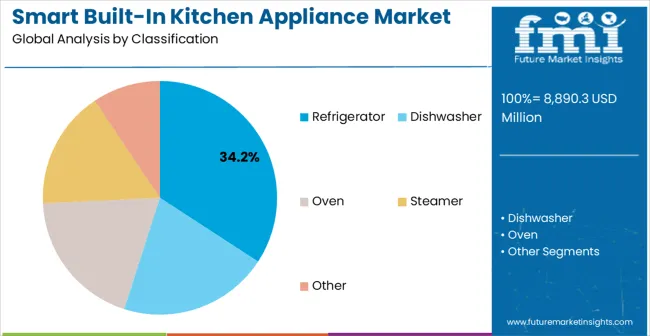
Market Position: Refrigerator systems command the leading position in the Smart Built-In Kitchen Appliance market with approximately 34.2% market share through advanced smart cooling technology, including temperature optimization, inventory management capability, and energy efficiency monitoring that enable users to maintain optimal food storage conditions across diverse household and commercial environments.
Value Drivers: The segment benefits from consumer preference for intelligent cooling systems that provide real-time temperature control, food inventory tracking, and energy consumption optimization without requiring significant behavioral changes. Smart refrigeration features enable automated temperature adjustments, spoilage alerts, and integration with shopping applications where connectivity and precision temperature control represent critical operational requirements.
Competitive Advantages: Refrigerator systems differentiate through advanced sensor technology, AI-powered food management features, and integration with smart home platforms that enhance operational effectiveness while maintaining optimal food preservation suitable for diverse residential and commercial applications.
Key market characteristics:
Dishwasher systems maintain a significant 23.8% market share in the Smart Built-In Kitchen Appliance market through intelligent cleaning cycles and water efficiency optimization. These systems appeal to environmentally conscious consumers requiring automated cleaning solutions with precise water and energy management features. Market growth is driven by sustainability initiatives emphasizing water conservation and operational efficiency through smart cleaning cycle optimization.
Smart oven systems hold approximately 21.4% market share, focusing on precision cooking technology and multi-function capabilities. These appliances demand advanced temperature control systems capable of operating with cooking automation and recipe integration features that provide consistent results across different food preparation scenarios.
Steamer systems account for approximately 12.1% market share through specialized healthy cooking applications and precise moisture control technology. The segment focuses on health-conscious consumers seeking automated steaming capabilities for vegetables, seafood, and grain preparation with optimal nutrition retention.
Other smart kitchen appliances represent approximately 8.5% market share, including specialized cooking devices, smart microwave systems, and integrated kitchen automation platforms for comprehensive culinary management.
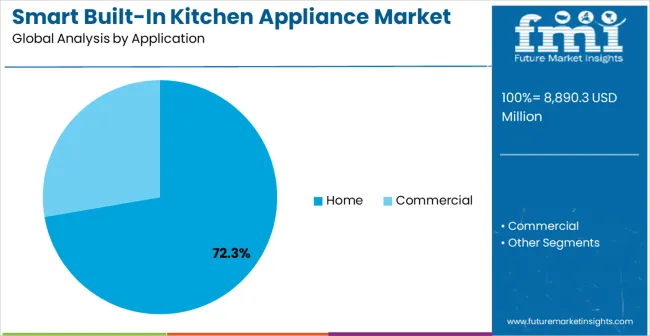
Market Context: Home applications dominate the smart built-in kitchen appliance market with approximately 72.3% market share due to widespread adoption of smart home technology and increasing focus on residential automation, energy management, and culinary convenience applications that enhance daily living while maintaining cost-effectiveness.
Appeal Factors: Home customers prioritize appliance connectivity, ease of use, and integration with existing smart home infrastructure that enables coordinated kitchen management across multiple appliances. The segment benefits from substantial consumer spending on home improvement and modernization programs that emphasize the acquisition of smart appliances for convenience and energy efficiency applications.
Growth Drivers: Smart home adoption programs incorporate built-in kitchen appliances as standard equipment for modern residential construction. In contrast, home renovation projects increase demand for connected appliance capabilities that comply with energy efficiency standards and provide enhanced user convenience.
Market Challenges: Varying home electrical infrastructure and internet connectivity differences may limit system standardization across different residential types or geographic locations.
Application dynamics include:
Commercial applications capture approximately 27.7% market share through specialized kitchen automation requirements in restaurants, hotels, institutional facilities, and food service operations. These establishments demand robust systems capable of operating in high-volume environments while providing precise control and operational efficiency capabilities.
Growth Accelerators: Home automation adoption drives primary demand as smart built-in kitchen appliances provide connectivity and control capabilities that enable households to achieve energy efficiency without compromising culinary convenience, supporting modern living requirements and environmental sustainability missions that require intelligent appliance management applications. Consumer lifestyle modernization demand accelerates market expansion as households seek effective kitchen automation tools that minimize manual oversight while maintaining cooking precision and energy optimization during food preparation and storage scenarios. Technology spending increases worldwide, creating sustained demand for smart appliances that complement traditional kitchen equipment and provide operational intelligence in connected home environments.
Growth Inhibitors: Initial investment challenges vary across income segments regarding the deployment of smart kitchen systems and connectivity costs, which may limit operational flexibility and market penetration in regions with limited disposable income or cost-sensitive households. Technical performance limitations persist regarding connectivity reliability and compatibility issues that may reduce effectiveness in areas with poor internet infrastructure, older electrical systems, or incompatible home automation platforms, affecting appliance performance and user satisfaction. Market fragmentation across multiple smart home standards and appliance manufacturers creates compatibility concerns between different system providers and existing household technology infrastructure.
Market Evolution Patterns: Adoption accelerates in developed residential markets and commercial establishments where technology investment justifies system costs, with geographic concentration in urban areas transitioning toward mainstream adoption in suburban markets driven by smart home standardization and appliance technology development. Technology development focuses on enhanced AI integration, improved connectivity reliability, and seamless compatibility with major smart home platforms, optimizing energy consumption and operational convenience. The market could face disruption if alternative home automation technologies or energy regulations significantly impact the deployment of smart appliances in residential or commercial applications.
The smart built-in kitchen appliance market demonstrates varied regional dynamics with Growth Leaders including China (21.1% market share) and India (19.5% market share) driving expansion through urbanization and rising disposable income development. Steady Performers encompass Germany (17.9% market share), Brazil (16.4% market share), and the USA (14.8% market share), benefiting from established smart home technology industries and advanced consumer electronics adoption. Mature Markets feature the UK (13.3% market share) and Japan (11.7% market share), where premium appliance applications and home automation technology integration support consistent growth patterns.
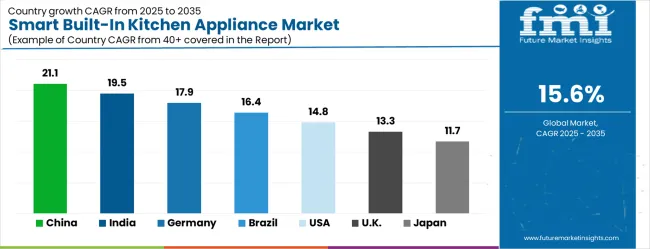
| Country | Market Share (2025) |
|---|---|
| China | 21.1% |
| India | 19.5% |
| Germany | 17.9% |
| Brazil | 16.4% |
| United States | 14.8% |
| United Kingom | 13.3% |
| Japan | 11.7% |
Regional synthesis reveals Asia-Pacific markets leading adoption through urbanization and smart home infrastructure development, while European countries maintain steady expansion supported by premium appliance technology advancement and energy efficiency requirements. North American markets show strong growth driven by home automation applications and connected device integration trends.
China establishes market leadership through aggressive urbanization programs and comprehensive smart home infrastructure development, integrating advanced smart built-in kitchen appliances as standard components in new residential developments and commercial kitchen installations. The country's 21.1% market share reflects government initiatives promoting smart city technology and domestic appliance manufacturing capabilities that mandate the use of connected kitchen systems in modern housing and commercial food service establishments. Growth concentrates in major urban centers, including Beijing, Shanghai, and Shenzhen, where smart home technology development showcases integrated kitchen appliances that appeal to affluent consumers seeking advanced home automation capabilities and energy efficiency applications.
Chinese manufacturers are developing cost-effective smart kitchen solutions that combine domestic production advantages with advanced connectivity features, including AI-powered cooking assistance and comprehensive home integration capabilities. Distribution channels through major electronics retailers and online platforms expand market access, while government support for smart home technology development supports adoption across diverse residential and commercial segments.
Strategic Market Indicators:
In Mumbai, Delhi, and Bangalore, affluent households and commercial establishments are implementing advanced smart built-in kitchen appliances as premium amenities for home automation and operational efficiency applications, driven by increasing disposable income and urbanization programs that emphasize the importance of modern kitchen technology capabilities. The market holds a 19.5% share, supported by growing middle-class purchasing power and residential construction initiatives that promote smart home features for new apartment complexes and commercial kitchen facilities. Indian consumers are adopting smart kitchen appliances that provide convenience, energy efficiency, and status symbol value, particularly appealing in urban areas where modern lifestyle and technology adoption represent important social considerations.
Market expansion benefits from growing consumer electronics manufacturing capabilities and international technology partnerships that enable local assembly of smart kitchen appliances for residential and commercial applications. Technology adoption follows patterns established in smartphones and consumer electronics, where brand recognition and feature richness drive purchasing decisions and operational deployment.
Market Intelligence Brief:
Germany's advanced home automation market demonstrates sophisticated smart built-in kitchen appliance deployment with documented operational effectiveness in residential applications and commercial kitchen facilities through integration with existing smart home systems and energy management infrastructure. The country leverages engineering expertise in appliance technology and home automation systems integration to maintain a 17.9% market share. Urban centers, including Munich, Hamburg, and Frankfurt, showcase premium installations where smart kitchen appliances integrate with comprehensive home automation platforms and energy management systems to optimize utility consumption and operational convenience.
German appliance manufacturers prioritize system reliability and EU energy standards in the development of smart kitchens, creating demand for premium appliances with advanced features, including precise temperature control and automated energy optimization systems. The market benefits from established home automation infrastructure and a willingness to invest in advanced kitchen technologies that provide long-term operational benefits and compliance with international energy efficiency standards.
Market Intelligence Brief:
Brazil's market expansion benefits from diverse residential demand, including luxury apartment developments in São Paulo and Rio de Janeiro, commercial kitchen modernization, and government housing programs that increasingly incorporate smart appliance solutions for modern living applications. The country maintains a 16.4% market share, driven by rising middle-class income and increasing awareness of smart home technology benefits, including energy efficiency and operational convenience capabilities.
Market dynamics focus on cost-effective smart kitchen solutions that balance advanced connectivity features with affordability considerations important to Brazilian households. Growing urbanization creates sustained demand for modern kitchen appliances in new residential construction and apartment renovation projects.
Strategic Market Considerations:
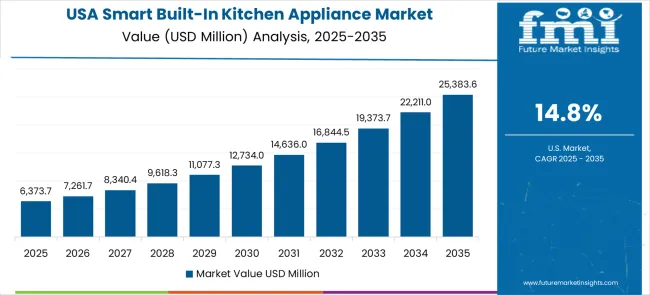
The USA market emphasizes advanced smart kitchen features, including precision cooking control and integration with comprehensive home automation platforms that manage energy consumption, security systems, and entertainment through unified control interfaces. The country holds a 14.8% market share, driven by home renovation trends and consumer electronics adoption that supports smart appliance integration. American households prioritize operational convenience with smart kitchen appliances delivering consistent performance through advanced connectivity algorithms and seamless integration capabilities.
Technology deployment channels include major home improvement retailers, specialized appliance dealers, and online platforms that support professional installation for complex smart home applications. Home automation compatibility with established smart home ecosystems expands market appeal across diverse household income levels seeking convenience and efficiency benefits.
Performance Metrics:
Japan demonstrates steady market development with an 11.7% market share, distinguished by households' preference for high-quality smart kitchen appliances that integrate seamlessly with existing home systems and provide reliable long-term operation in compact residential spaces. The market prioritizes advanced features, including precision temperature control, space optimization, and integration with comprehensive home management platforms that reflect Japanese consumer expectations for technological sophistication and operational excellence.
In London, Birmingham, and other urban centers, British households and commercial establishments are implementing advanced smart kitchen appliances to enhance modern living capabilities and support residential automation that aligns with energy efficiency goals and contemporary lifestyle standards. The UK market holds a 13.3% market share, driven by smart home modernization programs and appliance technology upgrades that emphasize connected kitchen systems for residential and commercial applications. British consumers are prioritizing smart kitchen appliances that provide energy efficiency, convenience, and integration with existing home automation systems, particularly important in urban properties and modern residential developments.
Market expansion benefits from government energy efficiency programs that incentivize smart appliance adoption through utility rebates and environmental standards, creating sustained demand across the UK's residential and commercial sectors, where operational efficiency and energy management represent critical requirements. The regulatory framework supports smart appliance adoption through energy efficiency standards and building codes that promote connected home technology aligned with sustainability capabilities.
Strategic Market Indicators:
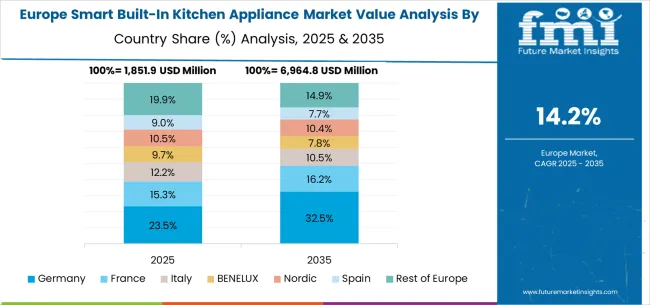
The European Smart Built-In Kitchen Appliance market is projected to grow from USD 1,892.5 million in 2025 to USD 8,073.4 million by 2035, registering a CAGR of 15.6% over the forecast period. Germany is expected to maintain its leadership position with a 35.8% market share in 2025, declining slightly to 35.4% by 2035, supported by its advanced home automation technology infrastructure and major appliance manufacturing centers, including Munich and Stuttgart.
France follows with a 24.2% share in 2025, projected to reach 24.8% by 2035, driven by comprehensive residential modernization programs and smart home technology development initiatives. The United Kingdom holds an 18.7% share in 2025, expected to maintain 18.3% by 2035 through premium appliance applications and energy efficiency requirements. Italy commands a 12.4% share, while Spain accounts for 8.9% in 2025. The Rest of Europe region is anticipated to gain momentum, expanding its collective share from 7.6% to 8.2% by 2035, attributed to increasing smart home adoption in Nordic countries and emerging Eastern European residential developments implementing home automation programs.
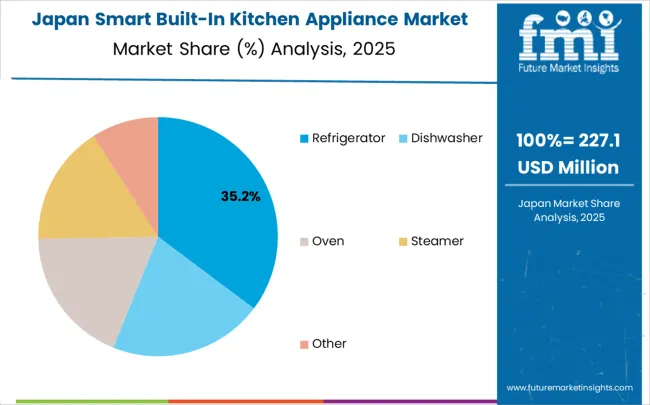
In Japan, the Smart Built-In Kitchen Appliance market prioritizes refrigerator systems, which capture the dominant share of residential and commercial installations due to their advanced features, including precision temperature control optimization and seamless integration with existing compact kitchen infrastructure. Japanese households emphasize efficiency, reliability, and space optimization, creating demand for smart refrigerators that provide intelligent cooling capabilities and food management features based on household consumption patterns and space constraints. Other appliance categories maintain secondary positions primarily in luxury applications and commercial kitchen installations where comprehensive automation functionality meets operational requirements without compromising space efficiency.
Market Characteristics:
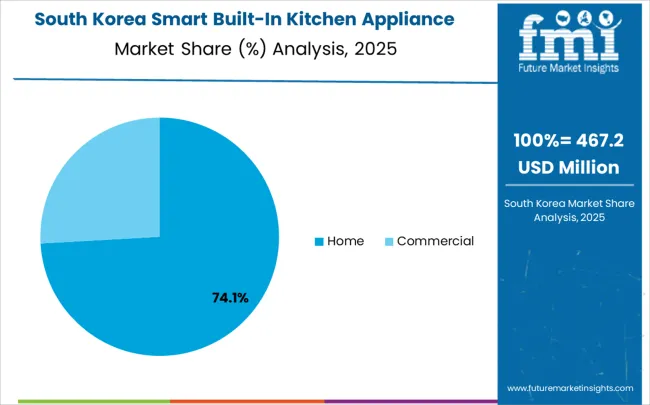
In South Korea, the market structure favors international appliance companies, including Samsung, LG Electronics, and BSH Hausgeräte GmbH, which maintain dominant positions through comprehensive product portfolios and established consumer electronics networks supporting both residential and commercial installations. These providers offer integrated solutions combining advanced smart kitchen appliances with professional installation services and ongoing technical support that appeal to Korean consumers seeking reliable home automation systems. Local electronics retailers and system integrators capture moderate market share by providing localized service capabilities and competitive pricing for standard residential installations. At the same time, domestic manufacturers focus on specialized applications and cost-effective solutions tailored for Korean household characteristics.
Channel Insights:
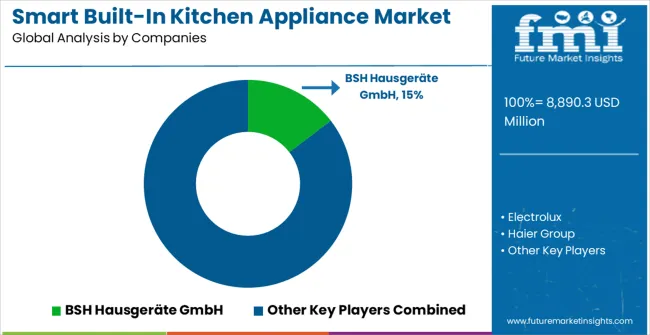
The smart built-in kitchen appliance market operates with moderate concentration, featuring approximately 12-15 meaningful participants, where leading companies control roughly 55-60% of the global market share through established consumer relationships and comprehensive product portfolios. Competition emphasizes advanced connectivity capabilities, system reliability, and smart home platform integration rather than price-based rivalry.
Market Leaders encompass BSH Hausgeräte GmbH, Electrolux, and Haier Group, which maintain competitive advantages through extensive appliance manufacturing expertise, global distribution networks, and comprehensive smart home integration capabilities that create customer loyalty and support premium pricing. These companies leverage decades of appliance technology experience and ongoing innovation investments to develop advanced smart kitchen systems with AI-powered features and seamless home automation integration.
Technology Innovators include Whirlpool Corporation, Panasonic Holdings Corporation, and LG Electronics, which compete through cutting-edge smart technology development and innovative user interfaces that appeal to tech-savvy consumers seeking advanced automation capabilities and operational convenience. These companies differentiate through rapid product development cycles and a specialized smart home integration focus.
Regional Specialists feature companies like Samsung, Gorenje, and Arcelik, which focus on specific geographic markets and specialized applications, including premium smart appliances and integrated kitchen automation solutions. Market dynamics favor participants that combine reliable hardware with advanced connectivity software, including AI-powered cooking assistance and automatic energy optimization capabilities. Competitive pressure intensifies as traditional appliance manufacturers expand into smart home technology while technology companies challenge established players through innovative control solutions and cost-effective platforms targeting diverse household segments.
| Item | Value |
|---|---|
| Quantitative Units | USD 8,890.3 million |
| Product Type | Refrigerator, Dishwasher, Oven, Steamer, Other |
| Application | Home, Commercial |
| Regions Covered | North America, Europe, Asia Pacific, Latin America, Middle East & Africa |
| Countries Covered | China, India, Germany, Brazil, the USA, the UK, Japan, and 25+ additional countries |
| Key Companies Profiled | BSH Hausgeräte GmbH, Electrolux, Haier Group, Whirlpool Corporation, Panasonic Holdings Corporation, LG Electronics, Samsung |
| Additional Attributes | Dollar sales by product type and application categories, regional adoption trends across North America, Europe, and Asia-Pacific, competitive landscape with appliance manufacturers and technology providers, consumer preferences for connectivity and energy efficiency, integration with smart home platforms and automation systems, innovations in AI-powered features and connectivity protocols, and development of comprehensive smart kitchen solutions with enhanced automation and energy management capabilities. |
The global smart built-in kitchen appliance market is estimated to be valued at USD 8,890.3 million in 2025.
The market size for the smart built-in kitchen appliance market is projected to reach USD 37,887.2 million by 2035.
The smart built-in kitchen appliance market is expected to grow at a 15.6% CAGR between 2025 and 2035.
The key product types in smart built-in kitchen appliance market are refrigerator, dishwasher, oven, steamer and other.
In terms of application, home segment to command 72.3% share in the smart built-in kitchen appliance market in 2025.






Our Research Products

The "Full Research Suite" delivers actionable market intel, deep dives on markets or technologies, so clients act faster, cut risk, and unlock growth.

The Leaderboard benchmarks and ranks top vendors, classifying them as Established Leaders, Leading Challengers, or Disruptors & Challengers.

Locates where complements amplify value and substitutes erode it, forecasting net impact by horizon

We deliver granular, decision-grade intel: market sizing, 5-year forecasts, pricing, adoption, usage, revenue, and operational KPIs—plus competitor tracking, regulation, and value chains—across 60 countries broadly.

Spot the shifts before they hit your P&L. We track inflection points, adoption curves, pricing moves, and ecosystem plays to show where demand is heading, why it is changing, and what to do next across high-growth markets and disruptive tech

Real-time reads of user behavior. We track shifting priorities, perceptions of today’s and next-gen services, and provider experience, then pace how fast tech moves from trial to adoption, blending buyer, consumer, and channel inputs with social signals (#WhySwitch, #UX).

Partner with our analyst team to build a custom report designed around your business priorities. From analysing market trends to assessing competitors or crafting bespoke datasets, we tailor insights to your needs.
Supplier Intelligence
Discovery & Profiling
Capacity & Footprint
Performance & Risk
Compliance & Governance
Commercial Readiness
Who Supplies Whom
Scorecards & Shortlists
Playbooks & Docs
Category Intelligence
Definition & Scope
Demand & Use Cases
Cost Drivers
Market Structure
Supply Chain Map
Trade & Policy
Operating Norms
Deliverables
Buyer Intelligence
Account Basics
Spend & Scope
Procurement Model
Vendor Requirements
Terms & Policies
Entry Strategy
Pain Points & Triggers
Outputs
Pricing Analysis
Benchmarks
Trends
Should-Cost
Indexation
Landed Cost
Commercial Terms
Deliverables
Brand Analysis
Positioning & Value Prop
Share & Presence
Customer Evidence
Go-to-Market
Digital & Reputation
Compliance & Trust
KPIs & Gaps
Outputs
Full Research Suite comprises of:
Market outlook & trends analysis
Interviews & case studies
Strategic recommendations
Vendor profiles & capabilities analysis
5-year forecasts
8 regions and 60+ country-level data splits
Market segment data splits
12 months of continuous data updates
DELIVERED AS:
PDF EXCEL ONLINE
Smart Meeting Pod Market Size and Share Forecast Outlook 2025 to 2035
Smart Electrogastrogram Recorder Market Size and Share Forecast Outlook 2025 to 2035
Smart Aerial Work Robots Market Size and Share Forecast Outlook 2025 to 2035
Smart Bladder Scanner Market Size and Share Forecast Outlook 2025 to 2035
Smart School Bus Platform Market Size and Share Forecast Outlook 2025 to 2035
Smart Home Wireless Smoke Detector Market Size and Share Forecast Outlook 2025 to 2035
Smart Bus Platform Market Size and Share Forecast Outlook 2025 to 2035
Smart Vision Processing Chips Market Size and Share Forecast Outlook 2025 to 2035
Smart Touch Screen Scale Market Size and Share Forecast Outlook 2025 to 2035
Smart Magnetic Drive Conveyor System Market Size and Share Forecast Outlook 2025 to 2035
Smart Wheelchair market Size and Share Forecast Outlook 2025 to 2035
Smart Mining Technologies Market Size and Share Forecast Outlook 2025 to 2035
Smart Parking Market Size and Share Forecast Outlook 2025 to 2035
Smart Digital Valve Positioner Market Forecast and Outlook 2025 to 2035
Smart Card IC Market Size and Share Forecast Outlook 2025 to 2035
Smart-Tag Inlay Inserters Market Analysis - Size and Share Forecast Outlook 2025 to 2035
Smart TV Market Forecast and Outlook 2025 to 2035
Smart/AI Toy Market Size and Share Forecast Outlook 2025 to 2035
Smart Locks Market Size and Share Forecast Outlook 2025 to 2035
Smart Sprinkler Controller Market Size and Share Forecast Outlook 2025 to 2035

Thank you!
You will receive an email from our Business Development Manager. Please be sure to check your SPAM/JUNK folder too.
Chat With
MaRIA